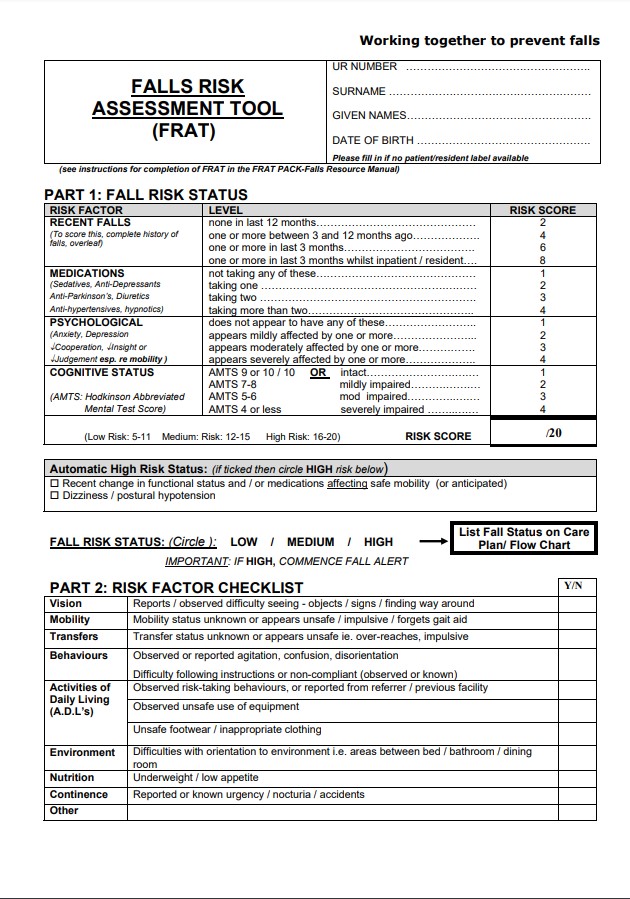The Definitive Guide to Dementia Fall Risk
Table of ContentsDementia Fall Risk - An OverviewNot known Incorrect Statements About Dementia Fall Risk An Unbiased View of Dementia Fall RiskRumored Buzz on Dementia Fall Risk
A fall danger analysis checks to see exactly how most likely it is that you will certainly drop. The evaluation typically consists of: This includes a series of questions concerning your overall wellness and if you've had previous falls or troubles with equilibrium, standing, and/or walking.STEADI consists of screening, analyzing, and intervention. Interventions are recommendations that might reduce your threat of dropping. STEADI includes three steps: you for your threat of falling for your risk factors that can be enhanced to try to avoid drops (for instance, balance issues, impaired vision) to reduce your danger of falling by making use of efficient techniques (for example, giving education and learning and resources), you may be asked several concerns including: Have you dropped in the past year? Do you feel unsteady when standing or walking? Are you bothered with falling?, your provider will test your stamina, balance, and stride, utilizing the following autumn assessment tools: This test checks your stride.
If it takes you 12 secs or more, it may mean you are at greater risk for a loss. This examination checks strength and equilibrium.
The positions will certainly get more difficult as you go. Stand with your feet side-by-side. Move one foot halfway onward, so the instep is touching the large toe of your other foot. Move one foot totally in front of the other, so the toes are touching the heel of your various other foot.
The Of Dementia Fall Risk
A lot of falls happen as a result of several contributing elements; as a result, managing the threat of falling begins with identifying the variables that contribute to drop danger - Dementia Fall Risk. Some of one of the most pertinent risk aspects include: History of prior fallsChronic medical conditionsAcute illnessImpaired stride and balance, lower extremity weaknessCognitive impairmentChanges in visionCertain high-risk drugs and polypharmacyEnvironmental aspects can likewise raise the threat for drops, consisting of: Insufficient lightingUneven or damaged flooringWet or unsafe floorsMissing or harmed handrails and get barsDamaged or improperly fitted tools, such as beds, wheelchairs, or walkersImproper use assistive devicesInadequate supervision of individuals residing in the NF, consisting of those that show hostile behaviorsA successful autumn danger administration program requires an extensive professional analysis, with input from all members of the interdisciplinary group

The treatment strategy ought to also include interventions that are system-based, such as those that advertise recommended you read a risk-free environment (ideal lights, click over here hand rails, order bars, etc). The effectiveness of the interventions must be reviewed periodically, and the treatment strategy modified as essential to show modifications in the fall threat assessment. Applying a fall danger administration system utilizing evidence-based best technique can reduce the occurrence of falls in the NF, while restricting the possibility for fall-related injuries.
Little Known Questions About Dementia Fall Risk.
The AGS/BGS guideline advises screening all grownups matured 65 years and older for autumn threat every year. This testing contains asking clients whether they have actually fallen 2 or more times in the past year or looked for clinical attention for an autumn, or, if they have not dropped, whether they really feel unstable when strolling.
People that have actually fallen when without injury should have their equilibrium and gait reviewed; those with stride or balance abnormalities ought to receive extra assessment. A history of 1 loss without injury and without stride or equilibrium issues does not call for more assessment past ongoing yearly autumn danger screening. Dementia Fall Risk. An autumn danger assessment is needed as component of the Welcome to Medicare exam

Dementia Fall Risk for Beginners
Recording a falls history is among the quality signs for autumn prevention and monitoring. A crucial component of risk assessment is a medicine review. Numerous classes of medicines raise loss threat (Table 2). copyright drugs specifically are independent predictors of falls. These medications often tend to be sedating, alter the sensorium, and harm equilibrium and gait.
Postural hypotension can usually be minimized by reducing the dose of blood pressurelowering medicines and/or quiting medicines that have orthostatic hypotension as a side result. Usage of above-the-knee assistance tube and resting with the head of the bed boosted may also reduce postural decreases in high blood pressure. The suggested elements of a fall-focused checkup are shown in Box 1.

A pull time higher than or equivalent to 12 secs suggests high autumn risk. The 30-Second Chair Stand test evaluates reduced extremity stamina and equilibrium. Being unable to stand up from a chair of knee height without making use of one's arms shows boosted fall risk. The 4-Stage Balance examination analyzes fixed equilibrium by having the individual stand in 4 settings, each gradually more tough.
 Jake Lloyd Then & Now!
Jake Lloyd Then & Now! Alfonso Ribeiro Then & Now!
Alfonso Ribeiro Then & Now! Jennifer Love Hewitt Then & Now!
Jennifer Love Hewitt Then & Now! Marcus Jordan Then & Now!
Marcus Jordan Then & Now! The Olsen Twins Then & Now!
The Olsen Twins Then & Now!